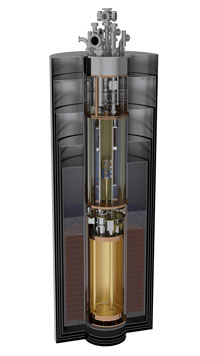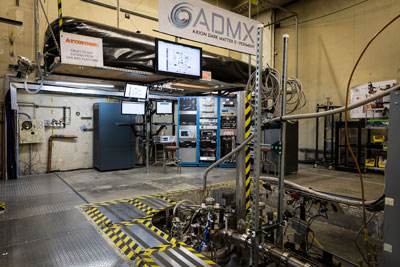Axion Dark Matter Experiment (ADMX)

A cutaway rendering of the ADMX detector, which can detect axions producing photons inside its cold, dark interior. Image: ADMX collaboration

Inside the ADMX experiment hall at the University of Washington. The ADMX detector is underground, surrounded by a magnetic field. Photo: Mark Stone/University of Washington
The Axion Dark Matter Experiment (ADMX) brings together scientists from 10 institutions from the United States and the United Kingdom to hunt for a theoretical particle called an axion, which may solve the mystery of dark matter. The experiment is managed by Fermilab and housed at the University of Washington.
What is an axion?
While much of the hunt for dark matter has focused on weakly interacting massive particles (WIMPs), a different theory suggests that the dark matter that holds galaxies together might be made up of a vast number of low-mass particles that are almost invisible to detection. Theorist Frank Wilczek named this particle the axion in the 1980s, and that decade saw the beginning of a 30-plus-year research and development effort to detect axions, if they exist.
How does ADMX work?
ADMX is an axion haloscope, which is basically a large, low-noise radio receiver that can be tuned to different frequencies. Axions almost never interact with matter, but with the aid of a strong magnetic field and a cold, dark, properly tuned reflective box, ADMX can detect photons created when axions convert into electromagnetic waves inside the detector. The team will turn the radio dial, testing millions of frequencies at an unprecedented level of sensitivity, listening for the telltale signs of axions.
The ADMX collaboration includes scientists at Fermilab, the University of Washington, Lawrence Livermore National Laboratory, Pacific Northwest National Laboratory, Los Alamos National Laboratory, the National Radio Astronomy Observatory, the University of California at Berkeley, the University of Chicago, the University of Florida and the University of Sheffield.
- Last modified
- 04/03/2018
- email Fermilab

